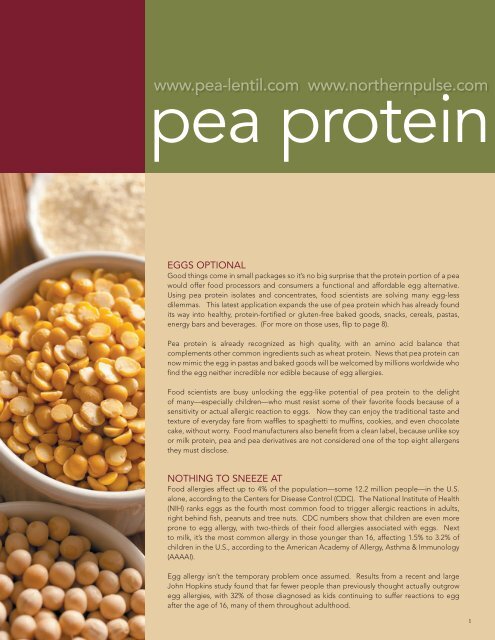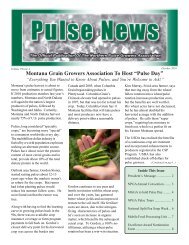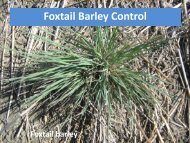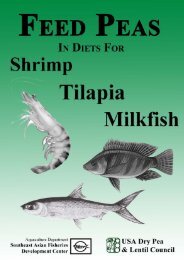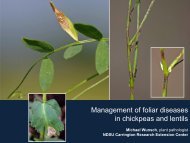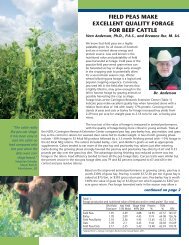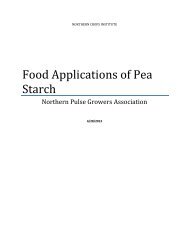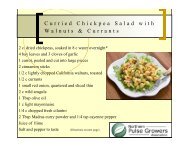Pea Protein - Northern Pulse Growers Association
Pea Protein - Northern Pulse Growers Association
Pea Protein - Northern Pulse Growers Association
- No tags were found...
You also want an ePaper? Increase the reach of your titles
YUMPU automatically turns print PDFs into web optimized ePapers that Google loves.
www.pea-lentil.com www.northernpulse.compea proteinEGGS OPTIONALGood things come in small packages so it’s no big surprise that the protein portion of a peawould offer food processors and consumers a functional and affordable egg alternative.Using pea protein isolates and concentrates, food scientists are solving many egg-lessdilemmas. This latest application expands the use of pea protein which has already foundits way into healthy, protein-fortified or gluten-free baked goods, snacks, cereals, pastas,energy bars and beverages. (For more on those uses, flip to page 8).<strong>Pea</strong> protein is already recognized as high quality, with an amino acid balance thatcomplements other common ingredients such as wheat protein. News that pea protein cannow mimic the egg in pastas and baked goods will be welcomed by millions worldwide whofind the egg neither incredible nor edible because of egg allergies.Food scientists are busy unlocking the egg-like potential of pea protein to the delightof many—especially children—who must resist some of their favorite foods because of asensitivity or actual allergic reaction to eggs. Now they can enjoy the traditional taste andtexture of everyday fare from waffles to spaghetti to muffins, cookies, and even chocolatecake, without worry. Food manufacturers also benefit from a clean label, because unlike soyor milk protein, pea and pea derivatives are not considered one of the top eight allergensthey must disclose.NOTHING TO SNEEZE ATFood allergies affect up to 4% of the population—some 12.2 million people—in the U.S.alone, according to the Centers for Disease Control (CDC). The National Institute of Health(NIH) ranks eggs as the fourth most common food to trigger allergic reactions in adults,right behind fish, peanuts and tree nuts. CDC numbers show that children are even moreprone to egg allergy, with two-thirds of their food allergies associated with eggs. Nextto milk, it’s the most common allergy in those younger than 16, affecting 1.5% to 3.2% ofchildren in the U.S., according to the American Academy of Allergy, Asthma & Immunology(AAAAI).Egg allergy isn’t the temporary problem once assumed. Results from a recent and largeJohn Hopkins study found that far fewer people than previously thought actually outgrowegg allergies, with 32% of those diagnosed as kids continuing to suffer reactions to eggafter the age of 16, many of them throughout adulthood.1
EGG-FREE ECSTASYImagine a busy mother being ableto offer her egg-sensitive childgoodies such as walnut-chocolatechip banana bread, coconut cake,sunflower cookies and blueberrymuffins. Or, a treat such as awaffle cone, as well as breakfastfare like strawberry pancakes andhazelnut biscotti. A quick, simplesupper of spaghetti and meatballsor cheese ravioli is no longer offlimitsbecause of an egg allergy.A “NICHE” MARKET OF 30 MILLION?Sensitivities to egg and egg-containing products explodes the market for afunctional egg replacer to more than 30 million people. Indeed, many peoplewho can’t tolerate egg products don’t have an actual egg allergy as medicallydefined, but rather a sensitivity to eggs. Egg intolerance produces manyof the same symptoms as egg allergy, such as inflammation and diarrhea.In England, some 53% of those recently surveyed had intolerance to eggwhite and 32% to egg yolk. While the CDC does not track food sensitivities,conservative estimates for the U.S. scaled that number back to 8-10% of thepopulation—still nearly 34 million consumers. That’s a lot of folks looking foran egg-free eating experience.DON’T THINK “GREEN”In fact, the only thing green about pea protein is the environment. As withpea fiber and pea starch, pea protein isolates and concentrates come from drysplit peas. Because peas are a legume plant that naturally makes and returnsnitrogen fertilizer back into the soil, they are as healthy to grow as they are toeat. But in the case of pea protein, that’s where the “green” stays. Non-GMOand low allergenic pea protein concentrates and isolates are creamy-whitepowders that blend conveniently into dry ingredients, liquids and batters.WELL-SUITED SURROGATE<strong>Pea</strong> and egg proteins are similar and both have similar emulsion characteristics.<strong>Pea</strong> protein has excellent foam stability, comparable to egg albumin.Depending on the product made, independent controlled baking tests foundthat pea isolates and concentrates can perform better than, equal to, or onlyslightly less functional than eggs in cookies, cakes, muffins or waffles.PUTTING PEA PROTEINTHROUGH THE PACESFood scientists at NorthDakota State University (NDSU)tested the egg replacementfunctionality of a pea proteinisolate containing 80% proteinand a pea protein concentratecontaining 50% protein instandard commercial cake mixesas well as cookies.THE CAKE TESTBoth white cake and chocolate cake mixes were made with eggs, pea proteinconcentrate, freeze-dried pea protein isolate and spray-dried pea proteinisolate. <strong>Pea</strong> protein produced denser cakes with greater moistness than cakesmade with eggs. <strong>Pea</strong> protein isolates produced cakes with comparable cakepeak heights. Objective measurements found the egg cakes had slightlybetter cake uniformity and a softer texture, but all the cakes were deemedvery tender and soft. Indeed, subjective measures found the pea protein andegg cakes difficult to differentiate in appearance. The pea protein cakes hadA.B.pea concentratefreeze-driedpea isolatespray-driedpea isolateeggs2The white cakes prepared from pea concentrate, pea isolates, and eggs. The top view isrepresented in A while B represents the cross-section of the corresponding cake.
FEASIBLE AND FUNCTIONALThus far, NDSU food scientists concluded that pea protein isolates not only performed comparable to eggs in their preliminary tests,but proved to be a viable alternative to the egg—especially in popular consumer baked goods. Expect to see results from morecomplex sensory tests in the future.While NDSU put pea proteins through controlled baking tests, food scientists at <strong>Northern</strong> Crops Institute (NCI), an outreachfood and crop facility also in Fargo, ND, optimized recipes using pea protein concentrate. Less refined than pea protein isolates,concentrates are produced via a dry milling process. Dry milled concentrates have slightly less protein than protein isolates; morestarch and can enhance texture and volume in many products. NCI replaced eggs in common baking formulas with a dry-milled peaprotein concentrate consisting of ~50% protein and ~12% starch. When recipes were optimized, the pea concentrate performedexceptionally well as an egg replacement on a variety of baked products and pastas (see pages 5-7 for recipes and nutritional facts).MISTAKE-PROOF PASTASPasta production at NCI showed that replacing eggs with pea protein concentrate not only lowers costs, but improves firmness,maintaining that desired texture even after overcooking. Expect classic bright golden yellow color, not only with traditional semolina,but even when using white wheat.Al dente pasta cooking time (min) avg. firmness (gcm/strand) avg. cooked weight (g) avg. cooking loss (%)100% Semolina 11 12.8 69.7 6.290% Semolina-10% pea protein concentrate 12 14.8 68.1 6.098% Semolina-2% egg white powder 12 15.7 68.8 5.0Overcooked pasta cooking time (min) avg. firmness (gcm/strand) avg. cooked weight (g) avg. cooking loss (%)100% Semolina 17 9.3 81.8 7.090% Semolina-10% pea protein concentrate 18 11.5 79.6 6.898% Semolina-2% egg white powder 18 11.7 78.1 5.6similar diameters, shrinkage values and weights compared with cakes made with eggs. <strong>Pea</strong> protein isolates produced cakes withcomparable cake peak heights.Cakes made with pea protein scored a 10 for moistness compared with an 8 for cakes made with eggs, with testers concluding thatcakes made with eggs had a slighter dry texture compared with cakes made with pea protein. Texture analysis on the chocolatecakes found that those made with pea protein had softer texture (lower peak load values) than the egg cakes after one day ofstorage, but slightly higher peak loads than egg cakes after two days of storage. Functionally, freeze-dried pea isolate performedsimilar to spray-dried isolate. (Cookie trial shown on next page.)cake height (cm)543210left edge 3/5 0 3/5 right edgelocation on cakeegg pea concentrate spray-dried pea isolate freeze-dried pea isolateThe heights and contour of white cakes prepared from pea concentrate,peas isolates, and eggs. The 0 represents the center of the cake while the3/5 indicates a measurement taken at 3/5 the distance from the edge ofthe cake.Affect of protein source on white cake parametersavg. shrinkage avg.protein source diameter (cm)** value (cm)** weight (g)**egg 19.5 0.8 400pea protein concentrate* 19.4 0.9 393spray-dried isolate* 19.6 0.7 391freeze-dried isolate 19.4 0.9 395* Commercial sources of pea protein concentrate and isolates.** The average values were determined from two cakes according to theAACC International method 10-91.01.3
www.pea-lentil.comwww.northernpulse.comw Double Chocolate CupcakeIngredients Grams Amount (Baker’s %)Hot brewed coffee 360 88Baker’s chocolate 84 20<strong>Pea</strong> protein concentrate 42 10Water at 75°C 123 30Vanilla extract 3.0 0.7All-purpose flour 410 100Sugar 645 157Unsweetened cocoa powder 124 30Baking soda 12.2 3.0Baking powder 3.1 0.8Salt 8.6 2.1Vegetable oil 165 40Milk 196 48Sour cream 244 60ProcedureMix chopped chocolate with hot coffee. Mix pea proteinconcentrate with water and vanilla extract. Mix all wetingredients. Add dry ingredients and mix on mediumspeed. Fill mufÞn pans. Bake at 300¡F for 20 minutes. Coolcompletely and spread the cupcake with frosting.Nutrition FactsServing Size (60g)Sunflower CookieIngredients Grams Amount (Baker’s %)<strong>Pea</strong> protein concentrate 23 12Water at 75°C 67 34Vanilla 4.0 2.0Shortening 89 45Margarine 114 57Sugar 215 108Brown sugar 110 55All-purpose flour 200 100Baking soda 6.0 3.0Salt 3.1 1.6Oatmeal 90 45Sunflower seeds 40 20Chopped butterscotch 60 30ProcedureMix pea protein concentrate with water and vanilla extract.Cream pea protein concentrate mixture, with shortening,margarine, and sugars. Add the rest of dry ingredients. Foldin sunßower seeds and butterscotch. Bake at 350¡F for 11minutes.Nutrition FactsServing Size (40g)6Amount Per ServingCalories 160 Calories from Fat 50% Daily Value*Total Fat 6g 9%Saturated Fat 1.5g 8%Trans Fat 0gCholesterol 5mg 2%Sodium 180mg 8%Total Carbohydrate 27g 9%Dietary Fiber 1g 4%Sugars 18g<strong>Protein</strong> 3gVitamin A 0% • Vitamin C 0%Calcium 2% • Iron 6%*Percent Daily Values are based on a 2,000 caloriediet. Your daily values may be higher or lowerdepending on your calorie needs:Calories 2,000 2,500Total Fat Less Than 65g 80gSaturated Fat Less Than 20g 25gCholesterol Less Than 300mg 300mgSodium Less Than 2,400mg 2,400mgTotal Carbohydrate 300g 375gDietary Fiber 25g 30gCalories per gram:Fat 9 • Carbohydrate 4 • <strong>Protein</strong> 4Amount Per ServingCalories 170 Calories from Fat 80% Daily Value*Total Fat 9g 14%Saturated Fat 3g 15%Trans Fat 1gCholesterol 5mg 2%Sodium 160mg 7%Total Carbohydrate 22g 7%Dietary Fiber 1g 4%Sugars 14g<strong>Protein</strong> 2gVitamin A 4% • Vitamin C 0%Calcium 0% • Iron 4%*Percent Daily Values are based on a 2,000 caloriediet. Your daily values may be higher or lowerdepending on your calorie needs:Calories 2,000 2,500Total Fat Less Than 65g 80gSaturated Fat Less Than 20g 25gCholesterol Less Than 300mg 300mgSodium Less Than 2,400mg 2,400mgTotal Carbohydrate 300g 375gDietary Fiber 25g 30gCalories per gram:Fat 9 • Carbohydrate 4 • <strong>Protein</strong> 4
THE REST OF THE STORYProviding food manufacturers and consumers with a functionalegg alternative is just the latest item in a growing list of practicalapplications for pea protein.Gluten-Free<strong>Protein</strong> SupplementsHigh-<strong>Protein</strong> PastasEnergy BarsDrink Mixes<strong>Protein</strong>-Fortified Baked GoodsCerealsExtruded SnacksSmoothies and ShakesPet FoodsENHANCED PROTEIN QUALITYRich in lysine, the high-quality amino acid balance of peaprotein makes it a perfect compliment to wheat protein whileits uncommon allergen status outshines soy and whey sources.If gluten-free is part of your product portfolio, the creamy-whitecolor and availability of pea protein also eclipses rice protein.What’s more, pea adds a pleasant nutty flavor versus the cereallikeflavor of wheat or rice.STABILITY—IN TRIPLICATEEmulsion stability.<strong>Pea</strong> protein holds on to both fat and water, making acreamy, stable emulsion that offers process stability, holdsflavor components together and improves shelf life.Process stability.<strong>Pea</strong> protein won’t lose its structure or functionality underhigh temperatures, pH fluctuations or pressure. Suchstability enables high-stress processes such as baking,deep frying and extrusion.Extrusion stability.<strong>Pea</strong> protein can replace gluten as a stabilizer in snacks andcereals, becoming part of a matrix that allows expansion;thereby maintaining desired structure, texture and shape.PRACTICAL, AFFORDABLE, FUNCTIONAL<strong>Pea</strong> <strong>Protein</strong> creates healthy as well as tasty snacks and nutritionbars with good “bite” and mouth feel. Maintain volumewithout expansion in bread crumbs and brownies. Include upto 11% pea protein to create high-protein pastas that withstandcooking and deliver traditional texture. Stretch gluten suppliesin conventional baked goods because pea protein mimics thebulk and structure of wheat flour. Or, tap into the $7 billiongluten-free market in the U.S. Create gluten-free snacks andcereals with popular shapes and texture by using pea proteinin conjunction with a non-cereal starch such as pea starch ortapioca to replace wheat or corn flour. Use pea isolates to makenutritious, 50% reduced-fat salad dressings with the mouthfeel, taste and stability of their full-fat counterparts. Dairy-freesmoothies also can get a high quality protein boost from peaisolates. And now, reduce market exposure to fluctuating eggcosts by using pea protein as an egg replacement in bakedgoods and pastas.CONCENTRATED PROTEIN BULLET<strong>Pea</strong> isolates are at least 80% protein—packing a powerfulprotein punch with lots of flexibility for other ingredients.Indeed, as little as 2% to 5% of a pea protein isolate added towheat flour is enough to hike the nutritional value without majorformula changes. Highly refined to reduce oligosaccharides,pea protein isolates offer improved flavor, mouth feel anddigestive ease. These attributes allow increased proteinlevels in foods such as high-fiber, high-protein, low-caloriebreads without changing their flavor. <strong>Pea</strong> protein isolatesusually contain little if no starch or fiber. But don’t fret aboutcardboard chewiness. <strong>Pea</strong> isolates provide their potent proteinboost without that mouth-drying woody taste.ONE SIZE NEEDN’T FIT ALL<strong>Pea</strong> protein isolates are commercially available in particle sizesranging from 150 to 400 microns to fit a variety of applications.Smaller particles sizes are well-suited for beverages, nutritionbars and any application where a smooth mouth feel is desired.Larger particle sizes operate like a molecular sponge—withexcellent water retention that reduces cooking loss, improvesyield and provides a moist mouth feel. Medium-sized particlesizes are available for applications that require a bit of bothattributes.<strong>Pea</strong> protein concentrates range from 35% to 60% proteinand may or may not have a starch component. <strong>Pea</strong> proteinconcentrates are generally larger in particle size than isolates(20 to 30 microns). Still a fine powder, the larger particle sizeof pea protein concentrates make them well-suited for waterabsorbingapplications and for enhancing texture in bakedgoods and pastas.Remember to store pea protein powders out of light andtightly sealed to maintain neutral flavor. Refrigeration aidsin maintaining freshness. For product sources or moreinformation, contact <strong>Northern</strong> <strong>Pulse</strong> <strong>Growers</strong> <strong>Association</strong>,www.northernpulse.com or USA Dry <strong>Pea</strong> & Lentil Council,www.pea-lentil.comwww.pea-lentil.comwww.northernpulse.comProject funded by:<strong>Northern</strong> <strong>Pulse</strong> <strong>Growers</strong> <strong>Association</strong>8


